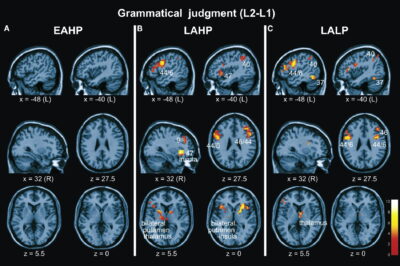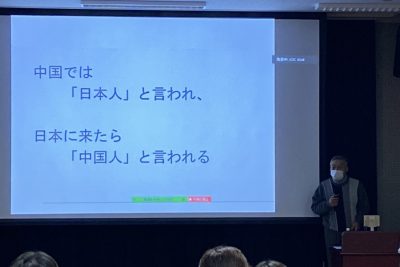UTokyo Class on Bilingualism (Part 2. of 2)

Continuing from Part 1. of 2.
This blog post was created as part of the interdisciplinary zengaku seminar "Different Dimensions of Bilingualism" offered at the University of Tokyo during the 2024 academic year.
===
"Okinawan languages in danger of extinction" by N.M. (Undergraduate student, The University of Tokyo)
As the Japanese government encouraged people in Okinawa to speak the standard Japanese dialect after the linguistic standardization initiated in the Meiji era, the number of people who speak Okinawan languages, shimakutuba, has decreased rapidly. According to the UNESCO’s Atlas of the World’s Languages in Danger, four of the Okinawan languages are definitely endangered, and two of the Okinawan languages are severely endangered (Moseley, 2010, 206-209). A survey conducted by the prefectural government’s Culture, Tourism, and Sports Department in 2020 reveals that although around 80% of the citizens of Okinawa feel close to an Okinawan language, the number of people who actually use one of the Okinawan languages beyond greetings is 43.2 % (see Fig.1). This is a decrease of 13.5 points from the previous survey conducted in 2019 (Ryukyu Shimpo, 2021). This strongly suggests that among Okinawa citizens, the familiarity with their native languages is declining.
To preserve its native languages, Okinawa Prefecture launched a project, Shimakutuba Archive Roadmap, in 2022 (Okinawa Prefecture, 2024). Its goal is to preserve the Okinawan languages by analyzing their grammar and making textbooks about Okinawan languages for students from elementary to high school. This is a positive attitude that encourages younger generations, who are the future of Okinawa, to feel more familiar with the Okinawan languages. Preserving the languages is also effective for protecting Okinawan culture.
The familiarity with the Okinawan languages is declining among the younger generations. The government has a sense of crisis about the loss of not only the languages but also the culture. Therefore, the authorities are taking actions to protect and pass on the native languages to the next generation.
References:
Morseley, C. Nicolas, A. (2010) Atlas of the World’s Languages in Danger. UNESCO. 206-209. https://unesdoc.unesco.org/ark:/48223/pf0000187026. Accessed June 26, 2024.
Okinawa Prefecture. (2024) しまくとぅばアーカイブ|沖縄県ホームページ. January 11, 2024.
https://www.pref.okinawa.lg.jp/bunkakoryu/bunkageijutsu/1022484/1009624.html. Accessed June 18, 2024.
Ryukyu Shimpo. (2021) Okinawan language usage down 13.5 points in FY 2020: 84% feel affection, 43% speak it. May 4, 2021. https://english.ryukyushimpo.jp/2021/05/11/33656/. Accessed June 18, 2024.
===
"Bilingualism and Age" by O.S. (Undergraduate student, The University of Tokyo)
Nowadays, Japanese elementary school students have more English classes than in the past (MEXT, 2019), and it seems that foreign language education at an early age is increasing in Japan. This text shows how bilingualism and age are related, mainly from the perspective of human brain activity.
Mechelli et al. (2004, 757) showed that grey-matter density increases “in the left inferior parietal cortex of bilinguals relative to monolinguals” but decreases as the acquisition age of their second language increases. This is consistent with the research that there is a critical period when the brain can be changed greatly and after which such an ability decreases (Hensch and Fagiolini 2005, 115). In addition, Wartenburger et al. (2003, 160) reported that regarding grammatical tasks, early acquisition high proficiency (EAHP) bilinguals used their brains in the same way in their first and second language while late acquisition high proficiency (LAHP) bilinguals used more areas in their brains in their second language (Figure 1).

Figure 1. The comparison between the activation of brains of EAHP bilinguals and LAHP bilinguals when they use their first and second language. (Wartenburger et al. 2003, 166)
Based on these studies, we can conclude that learning a second language at an early age is more effective regarding structural brain changes and the similar use of the first and second language in terms of brain activation. Nevertheless, there are other factors that affect bilingual brains such as language proficiency and the environment (Paradis and Jia 2017, 12; Mechelli et al. 2004, 757).
References:
Hensch, T. K., & Fagiolini, M. (2005) Excitatory–inhibitory balance and critical period plasticity in developing visual cortex. Progress in brain research, p. 115-124. https://www.sciencedirect.com/science/article/abs/pii/S0079612304470095, Accessed: June 14, 2024.
Mechelli, A., Crinion, J. T., Noppeney, U., O'Doherty, J., Ashburner, J., Frackowiak, R. S., &
Ministry of education, culture, sports, science and technology [MEXT]. (2019). 新学習指導要領全面実施に向けた小学校外国語に関する取組について.
https://www.mext.go.jp/b_menu/shingi/chukyo/chukyo3/004/siryo/__icsFiles/afieldfile/2019/09/11/1420968_2.pdf, Accessed: June 14, 2024.
Paradis, J., & Jia, R. (2017) Bilingual children's long‐term outcomes in English as a second language: language environment factors shape individual differences in catching up with monolinguals. Dev Sci, 20: e12433.
https://doi.org/10.1111/desc.12433, Accessed: June 14, 2024.
Price, C. J. (2004) Structural plasticity in the bilingual brain. Nature, 2004, p. 757-757. https://www.nature.com/articles/431757a, Accessed: June 14, 2024
Wartenburger, I., Heekeren, H. R., Abutalebi, J., Cappa, S. F., Villringer, A., & Perani, D. (2003) Early setting of grammatical processing in the bilingual brain. Neuron, 159-170. https://www.cell.com/fulltext/S0896-6273(02)01150-9#gr3, Accessed: June 14, 2024.
===
"Sign Language in Japan" by O Simon (Undergraduate student, The University of Tokyo)
This article observes sign languages for deaf people through the modality of sight. Sign languages use sight and spoken languages use sound, so naturally they have quite different characteristics. For instance, sign languages use both hands and faces, which means that various articulatory organs are used. Thus, the speaker can express a verb by hands and simultaneously an adverbial expression by face, which is impossible with spoken languages (Oka 2011, 90).
This very feature of sign languages has long been unnoticed, and it was strongly believed that they were inferior languages with no grammar and an abundance of abbreviations. Sign languages were banned in schools for deaf people in Japan, and they were forced to use a spoken language, or a sign language with the grammar of a spoken language (Saito 2007, 67). Nowadays, the situation is getting better, but there are not yet enough teachers who can use sign languages and deaf children still cannot learn with their first languages (JFD 2019, 90).
It is only recently that sign languages gained recognition as a genuine language, and circumstances have been improving. There are now news programs in sign language.
A number of local governments are legislating a Sign Language Act. The Japanese government, however, has not legislated one yet, and the right for deaf people to use sign language is still not duly reserved. For example, deaf people have to pay for an interpreter themselves, which causes an extra expense only because they are deaf (JFD 2019, 211). In order to improve such a situation, the Japanese government should legislate a Sign Language Act as soon as possible and expand the support for the use of sign languages.
References:
JFD (2019) Japanese Federation of the Deaf. White Paper of Sign Languages—Aiming for Multilingual Society”, Akashi Publishing, Tokyo.
Oka N., Akahori H. (2011) Grammar from Basic—How Japanese Sign Language Works, TAISHUKAN Publishing, Tokyo.
Saito K. (2007) Sign Language as a Minority Language. University of Tokyo Press, Tokyo.
NHK (2024). Sign Language CG for Weather and Disaster Prevention, NHK, https://www.nhk.or.jp/handsign, Accessed on June 16, 2024
===
"Bilingualism of Migrant Workers in Japan" by Ziyu Yang (Undergraduate student, The University of Tokyo)
Due to the declining birthrate and aging population in Japan, a migrant labor force, mostly from southeast Asia, is now in high demand. Many migrant workers arrive in Japan with little or no knowledge of the Japanese language (Roberts 2024, 22). As a result, they often rely on their native languages or English for daily communication within their communities.
Learning Japanese becomes essential for daily life and better job performance. However, the accessibility of language learning resources can vary significantly. One of the main reasons is the prevailing prejudice towards migrants in Japanese society (Hashimoto, 2022, 564). For example, in 2020, the Agency for Cultural Affairs of the Japanese government created an online language program for ‘foreign nationals as residents” in remote areas for language training. However, the Agency offers Japanese language programs only for refugees, but not for migrants (Agency for Cultural Affairs, 2020). This difference highlights a broader issue of institutional bias and a lack of support for migrants, who often face significant difficulties in accessing language education in Japan.
Migrant workers play an important role in Japan's economy, particularly in sectors with labor shortages. Nevertheless, communication and bilingualism pose challenges related to their convenience at work and everyday life. Policy improvements and support systems are crucial to addressing these problems and enhancing the well-being of migrant workers in Japan.
Reference
Agency for Cultural Affairs. (2020). Website for foreign nationals as residents to learn Japanese language: Connect and enhance your life in Japanese. https://tsunagarujp.mext.go.jp/howto. Accessed: 2024/07/04.
Hashimoto, K. (2022) Language, Mobility and Employability among Southeast Asian Migrant Workers in Japan. Asian Studies Review, 46 (4). pp.559-573.
Nikkei A. (2022) Japan is finally facing up to its economic need for immigrants, November 8, 2022.
https://asia.nikkei.com/Opinion/Japan-is-finally-facing-up-to-its-economic-need-for-immigrants. Accessed: 2024/07/04.
Roberts. G., Fujita. N. (2024) Low-Skilled Migrant Labor Schemes in Japan’s Agriculture: Voices from the Field. Social Science Japan Journal, 2024 (27). pp.21-39.








